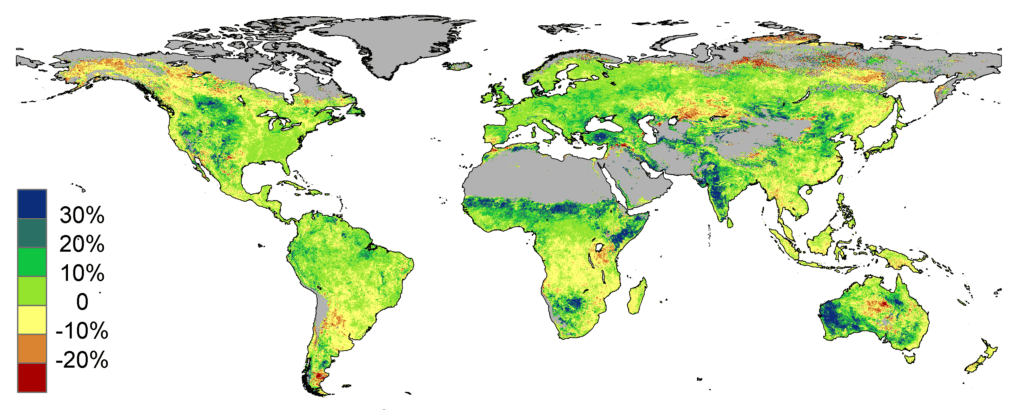
Increased levels of carbon dioxide (CO2) have helped boost green foliage across the world’s arid regions over the past 30 years through a process called CO2 fertilisation, according to CSIRO research.
In findings based on satellite observations, CSIRO, in collaboration with the Australian National University (ANU), found that this CO2 fertilisation correlated with an 11 per cent increase in foliage cover from 1982-2010 across parts of the arid areas studied in Australia, North America, the Middle East and Africa, according to CSIRO research scientist, Dr Randall Donohue.
“In Australia, our native vegetation is superbly adapted to surviving in arid environments and it consequently uses water very efficiently,” Dr Donohue said. “Australian vegetation seems quite sensitive to CO2 fertilisation.
This, along with the vast extents of arid landscapes, means Australia featured prominently in our results.”
“While a CO2 effect on foliage response has long been speculated, until now it has been difficult to demonstrate,” according to Dr Donohue.
“Our work was able to tease-out the CO2 fertilisation effect by using mathematical modelling together with satellite data adjusted to take out the observed effects of other influences such as precipitation, air temperature, the amount of light, and land-use changes.”
The fertilisation effect occurs where elevated CO2 enables a leaf during photosynthesis, the process by which green plants convert sunlight into sugar, to extract more carbon from the air or lose less water to the air, or both.
If elevated CO2 causes the water use of individual leaves to drop, plants in arid environments will respond by increasing their total numbers of leaves. These changes in leaf cover can be detected by satellite, particularly in deserts and savannas where the cover is less complete than in wet locations, according to Dr Donohue.
“On the face of it, elevated CO2 boosting the foliage in dry country is good news and could assist forestry and agriculture in such areas; however there will be secondary effects that are likely to influence water availability, the carbon cycle, fire regimes and biodiversity, for example,” Dr Donohue said.
The Latest Bing News on:
Rising CO2
- Getting to a Zero-Emission Future through Cleaner Energyon May 8, 2024 at 12:38 pm
The world warms more when there is more carbon dioxide in the atmosphere, which functions as the earth’s thermostat. Global greenhouse ...
- Growth in Atmospheric Carbon Dioxide Sets 12-Month Record, Scripps Reportson May 8, 2024 at 12:27 pm
The monthly average concentration of carbon dioxide in the atmosphere measured at Mauna Loa Observatory in March showed a record 12-month increase, the Scripps Institution of Oceanography announced ...
- Daily on Energy: US and China meet on climateon May 8, 2024 at 10:45 am
U.S. and China climate officials are meeting today in Washington to discuss working together to combat climate change within the decade – the first formal negotiating meeting between White House ...
- A $100 million carbon-removal competition enters its final stageon May 8, 2024 at 5:00 am
Over 1,000 companies and research teams are now working to remove carbon dioxide from the sky or ocean and permanently lock it away — up from just a handful of ventures a decade ago. As the planet ...
- The first new US aluminum plant in decades plans big emissions cutson May 6, 2024 at 8:31 pm
The facility, dubbed the Green Aluminum Smelter, could double the amount of virgin, or primary, aluminum the country produces while emitting 75 percent less CO2 than older smelters ... shuttered since ...
- 5 reasons every QSR should use CO2 monitoring solution for inventoryon May 6, 2024 at 6:08 am
Today's telemetry keeps a real-time watch on gas and other inventory with incredible precision — within a fraction of 1%. This assures QSR owners the ability to spot and alert problems as soon as they ...
- Higher CO2 levels mean viruses live longer, infect moreon April 28, 2024 at 11:41 pm
Carbon dioxide is key to how long airborne viruses hang around in the air and, therefore, their likelihood of spreading. Opening a window may be a more scientific way to avoid the spread of ...
- Increasing CO2 in air alters nutritional value of riceon April 24, 2024 at 5:00 pm
In a recently published study (May 23, Science Advances) we worked with scientists from Australia, China, Japan, and the United States to assess how the rising carbon dioxide concentrations that ...
- Carbon Dioxide Levels Have Passed a New Milestoneon April 19, 2024 at 4:59 pm
Currently, carbon dioxide levels are rising at near-record rates. According to data released by the National Oceanic and Atmospheric Administration’s Global Monitoring Laboratory earlier this ...
- Ice age climate analysis reduces worst-case warming expected from rising CO2on April 16, 2024 at 5:01 pm
Ice age climate analysis reduces worst-case warming expected from rising CO2. ScienceDaily . Retrieved May 7, 2024 from www.sciencedaily.com / releases / 2024 / 04 / 240417182709.htm ...
The Latest Google Headlines on:
Rising CO2
[google_news title=”” keyword=”rising CO2″ num_posts=”10″ blurb_length=”0″ show_thumb=”left”]
The Latest Bing News on:
CO2 fertilisation
- CO2 - Weather warnings issuedon May 3, 2024 at 5:01 pm
Today will be largely cloudy with heavy showers during the morning. In the afternoon, they will slowly clear northwards, leaving largely it dry by evening, with the chance of some late sunshine ...
- ‘It's Got to Be a Fight': Surviving Climate Breakdown & Saving Species of a ‘Tarnished Eden'on April 30, 2024 at 7:41 am
Adam Welz's The End of Eden is an extraordinary document of a planet under stress. Taking a deep dive into the scientific history of our planet, ...
- Will the Amazon Help Save the Planet?on April 21, 2024 at 5:00 pm
Without it, carbon dioxide would build up more quickly in ... This possible protective effect is called carbon fertilization. Buried deep in their code, most global climate models assume that ...
- Citizens' Climate Lobby: The challenge to remove carbonon April 21, 2024 at 1:01 am
The CO2 is then stored underground ... store trapped carbon in the seafloor and deep waters for centuries. Ocean-Fertilization has the potential to be both a low-cost and successful, high-capacity ...
- Climate change affects potato cultivation in South Koreaon April 19, 2024 at 2:47 am
"Our results show that the CO2 fertilization effect can offset the negative effects of rising temperatures and increase yields of spring potatoes by up to 60 percent if planting times are adjusted ...
- Inspired by natureon April 14, 2024 at 5:00 pm
Converting carbon dioxide into methanol, a potentially renewable alternative fuel, offers an opportunity to simultaneously form an alternative fuel and cut down on carbon dioxide emissions. Inspired ...
- Taking CO2 out of the air would be an absurdly expensive way to fight climate changeon April 11, 2024 at 12:14 pm
Solving climate change is a numbers game, and the goal — as defined by the United Nations Intergovernmental Panel on Climate Change — is to reach net-zero carbon dioxide emissions by roughly 2050.
- No, ice core study does not show CO2 is 'not the cause of warming' | Fact checkon April 11, 2024 at 9:12 am
Clark references a 2003 ice core study that reported temperatures increased hundreds of years before CO2 levels in Antarctica about 240,000 years ago. "CO2 clearly cannot be causing temperature ...
- This Company Removes Carbon Dioxide Directly From the Airon April 10, 2024 at 9:59 am
To keep global warming in check, the world needs to remove billions of tons of carbon dioxide by 2100. Swiss company Climeworks uses direct air capture technology to remove carbon dioxide from the ...
- Ocean Visions Unveils Ocean Iron Fertilization (OIF) Site Suitability Planning Toolon April 10, 2024 at 7:21 am
Several marine carbon dioxide removal (mCDR) approaches are being explored, but each requires additional research and testing. “The Ocean Iron Fertilization Site Suitability Planning Tool pairs ...
The Latest Google Headlines on:
CO2 fertilisation
[google_news title=”” keyword=”CO2 fertilisation” num_posts=”10″ blurb_length=”0″ show_thumb=”left”]











